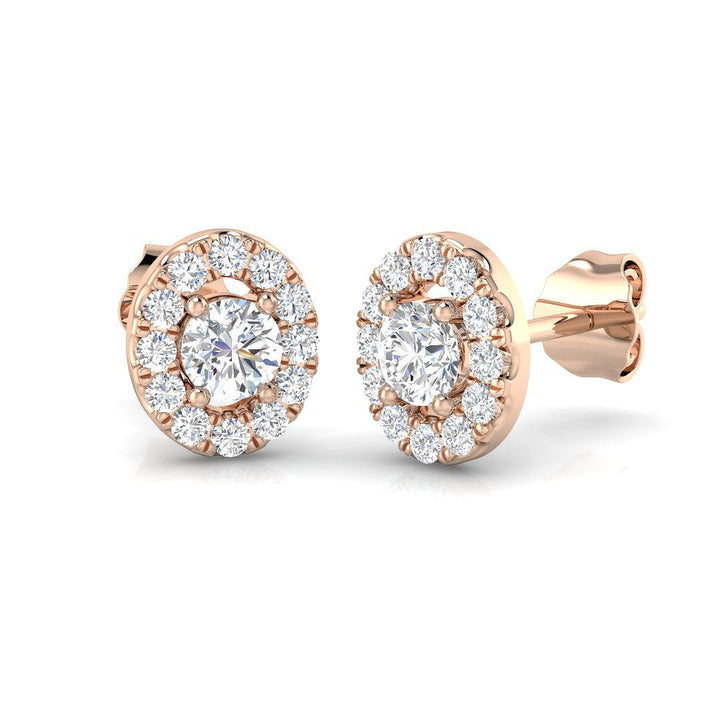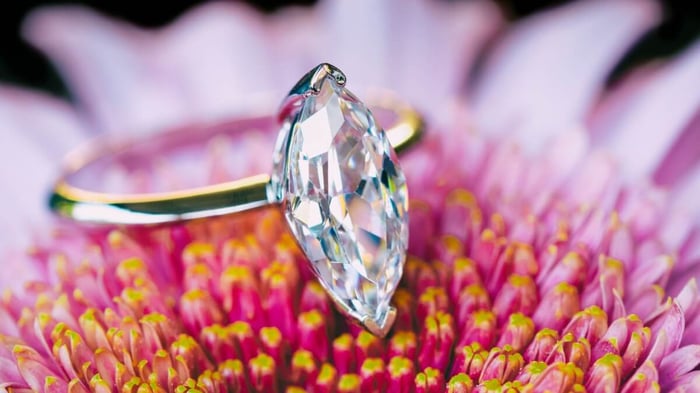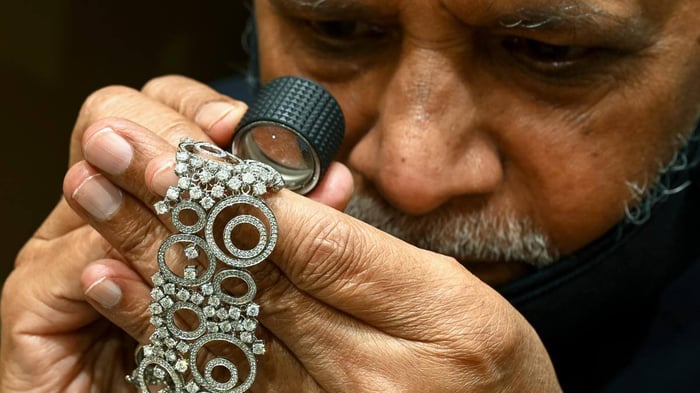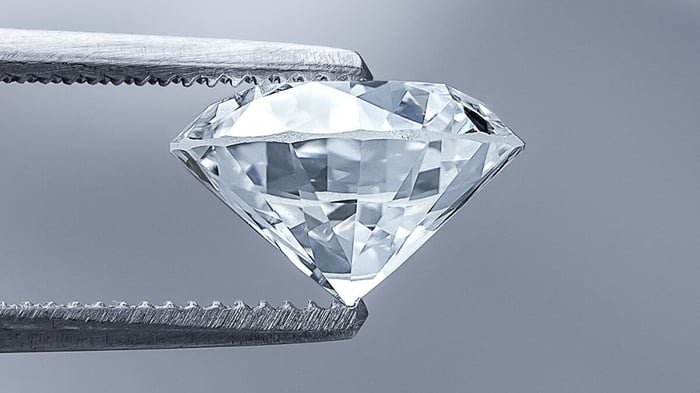A Marquise Diamond Buying Guide
Whether you're buying a diamond for yourself or a loved one, a marquise cut diamond is a great way to add sparkle and elegance to your jewellery collection. The marquise has a colourful and interesting history. And because of its history, it's one of the most romantic stones around. They are also known as football-shaped diamonds, boat-shaped diamonds and navettes.
The shape of the marquise diamond is a modified version of the brilliant-cut. It gets its name from the famous French woman, Marquise of Pompadour, who inspired King Louis XIV by looking at her mouth. The most distinctive feature is its rugby ball shape. A marquise diamond's shape shines into the modern era and will add glamour to your engagement ring.
The shape of a marquise diamond is elongated, which makes it ideal for stud earrings or ring settings. Because it has a shallow profile, this shape is perfect for complimenting almost any hand. It is also a good choice for short fingers, as its pointed ends make the fingers look longer than they are.
Marquise Bow Tie Effect
Unlike other diamond shapes, marquise diamonds have a bow tie effect. The bow tie is caused by the elongated shape of the stone. The bow tie is a dark area running across the broadest part of the diamond. If the bow tie effect is pronounced, it will reduce the visible brightness of the stone.
Diamonds with a visible bow tie effect tend to have a lower carat weight. Therefore, it's best to avoid buying a Marquise diamond less than around 1 carat in weight. The bow-tie effect is most pronounced in diamonds where the diamond's proportions are not good, where the diamond is cut too wide in relation to its length, see below for more information.
Get The Right Table!
When choosing a marquise diamond, its table is an important aspect. The table is the top of the diamond stone where most light enters, and it's crucial to get the right proportions—the bigger the table, the better the sparkle. However, bigger doesn't mean brighter. A high-quality table percentage will give you excellent performance and sparkle. Choosing a marquise with a high table percentage is essential if you're in the market for a diamond of this shape. Ideally, Marquise diamonds typically have a 1.85 – 2.00 ratio, making their length around twice the size of the width, which is considered an ideal balance.
Evaluate The Shape Of Your Marquise Diamond
Before buying a marquise diamond, it's essential to know how to evaluate its shape and cut. The elongated shape gives the illusion of a larger stone. This has the benefit of providing a larger looking stone than, for example, a round diamond of the same carat weight – an excellent way to buy an impressive piece of diamond jewellery at a relatively lower cost.
The shape of a marquise diamond is significant because it can make the diamond look larger or smaller. The longer the diamond is, the more delicate it will be at the ends. A shorter diamond will be more durable and might be a better choice in a ring worn every day, such as an engagement ring.
Moreover, a larger marquise diamond may appear darker at its points than a smaller one—the larger the stone, the better the sparkle. If you want a high-quality diamond, a large table percentage means the stone has perfect table proportions.
Ideally, the length to width ratio should be in the range of 1.7 to 2 to 1. If the proportions fall outside this range, the stone will look overly slender or too chunky. Overly wide marquise diamonds are also more prone to the bow tie effect, which dulls the stone's brilliance.
Colgante de gota de diamantes redondos y de talla baguette 0,75 ct G/SI Oro blanco de 18 k

€1.404,95
Una combinación perfectamente equilibrada de gemas de diamantes redondos y de talla baguette se engasta a mano en nuestro taller del Reino Unido para producir un llamativo colgante en este hermoso collar. Con tres cuartos de quilate de diamantes de… read more
The length of a marquise diamond is important. It's the width of a diamond that will make the stone look wider. In addition, it should have a good table percentage. Generally, a marquise diamond with a good table percentage is a good choice. A large table does not necessarily mean a higher-quality diamond because the clarity and cut quality also affect the overall appeal of the diamond, no matter the size of the diamond's table.
The size of the table is a crucial factor when buying a marquise diamond—the larger the table, the better the sparkle. A smaller table can make a stone look small. Look out for a diamond with a table that is two-thirds of the size of the carat number; for example, if the diamond is 1 carat, look out for a table size of 0.7.
Finally, in respect of the marquise diamond's shape, look out for the stone's symmetry. The points of the diamond should line up almost perfectly. Many people will notice even minimal misalignment, which will detract from the beauty of the stone and the jewellery into which it is set.
Aretes Oval Halo de Diamantes 0.60ct Calidad G/SI en Oro Rosa 18k

€1.300,95
Estos aretes de halo de diamantes tienen un óvalo deliciosamente curvo de diamantes relucientes, con un halo de piedras preciosas dispuestas con precisión para lograr un efecto llamativo. Esta joyería de diamantes es un excelente ejemplo de la artesanía que… read more
Marquise Diamond Colour
Marquise Diamonds can come in many colours, just as with any diamonds. Most people choose clear or white diamonds; however, fancy coloured diamonds come in various colours, including yellow, black, pink, blue or green. When selecting a white or clear diamond, aim for a colour grade of G or better for most sizes; however, larger diamonds benefit from a higher colour grade. Smaller stones can have a slightly lower colour grade and still be acceptable. As long as the diamond looks clear and does not have a visible yellow hue, then the diamond's colour grade should be fine. At All Diamond, we aim to use G colour grade diamonds as this gives the best compromise between colour and price.
Colour is often a personal preference, but it's also essential to consider the size of the diamond. If you're buying a diamond for a loved one, a marquise with a given colour grade will be more expensive than a round stone of the same weight and colour. Regardless of its size, a marquise cut diamond's colour is important.
Check The Setting Of Your Marquise Diamond
A marquise diamond needs an appropriate setting to protect the delicate diamond tips. Look for settings with two prongs securely holding and protecting the tips. The prongs should each look like tiny arrowheads covering each end of the stone. This setting style keeps the long diamond stable on the jewellery so that a knock will not chip the stone or twist the diamond on the ring.
Marquise Diamonds Are Not Just For Rings!
The marquise shape looks extremely elegant, suspended from the ear or as a pendant on a necklace. While many people love marquise cut diamond rings, this shape works very well in pendant earrings and necklaces. When used in earrings and necklaces, there is less of an issue with the durability of the pointed ends of the diamond.
Please check out our range of fine diamond jewellery, all designed and handcrafted in the United Kingdom. We hope you see examples of our artisan's work that inspire you for your next jewellery purchase!




